The Anasazi People: Ancient Ones
DIGITAL EFFECT: Anasazi People
Crossfade the scene to the coordinates of Chaco Canyon (36.06°N 107.97°W), on the date of the 1054 A.D. supernova—1054/07/05—about one hour before sunrise (with the atmosphere off).
VISUAL 13 (still): Map with Chaco Canyon Marked
Now we travel several hundred miles south to Chaco Canyon in northwest New Mexico.
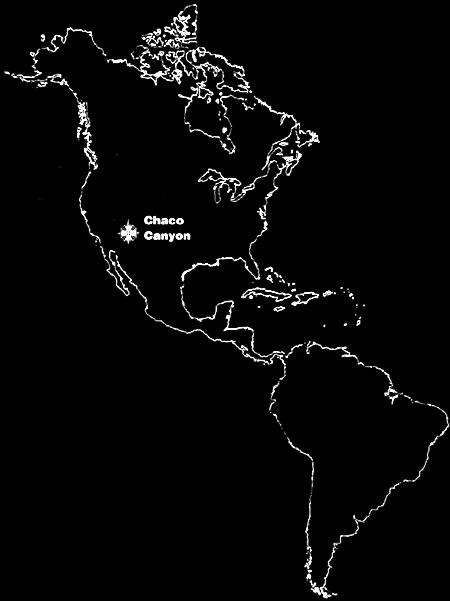
VISUAL 14 (still): Sun Watcher at Chaco Canyon
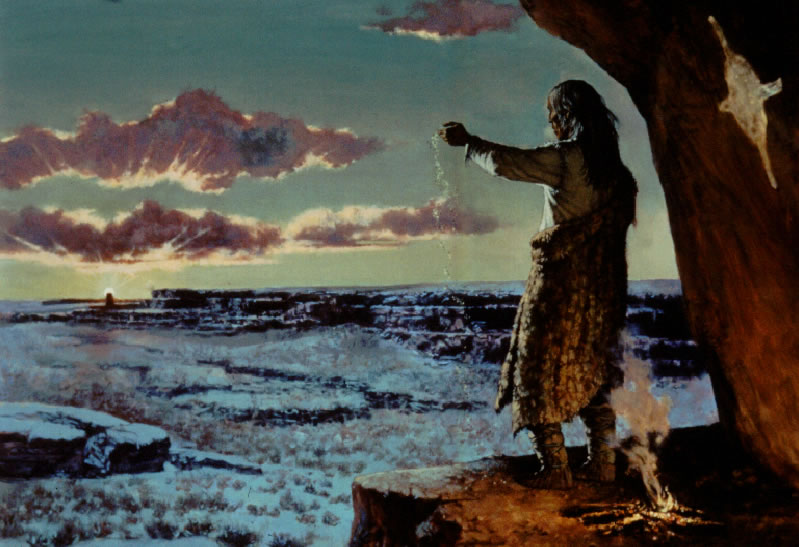
[Fade on a small image of the view of the Sun Watcher image at the marked position on the map, and then scale up and move the image off to the side for viewing.]
Here we see an Anasazi (On-a-sazz-ee) Sun watcher as he may have appeared in ancient times, observing the sunrise at the summery solstice. A rock painting or petroglyph, on the rock wall behind the Sun watcher, marks the precise place to stand to observe this summer solstice sunrise.
VISUAL 15 (still): Person Next to Butte at Sunrise
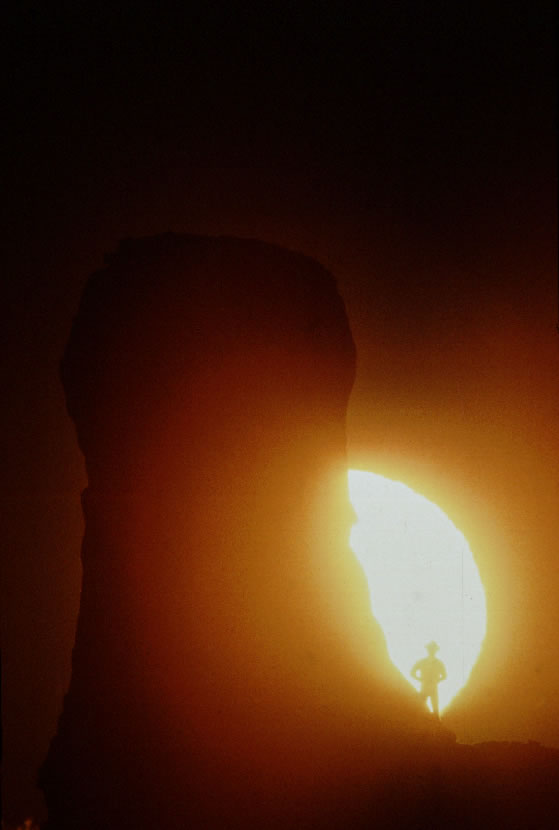
Fade on a small image of the view of Butte Sunrise image at the butte in the Sun Watcher image, and then scale up and move the image off to the side for viewing.
Today at Chaco Canyon we can observe the same sunrise. Chaco Canyon is a National Historical Monument.
Have you ever been there?
The people who live nearby say that Chaco Canyon was built by the Anasazi, which means “Ancient Ones.” At Chaco Canyon, there are 13 prehistoric towns and hundreds of minor ruins carefully constructed to align with the four cardinal directions and the four solstice directions of sunrise and sunset.
Like many other sky watchers, the Anasazi looked for signs in the sky as guidance.
Fade off the Sun Watcher and the Butte Sunrise images.
What could they have seen in the sky at night?
[Constellations, comets, planets, Moon, …]
Optional—Meteor or Bolide Effect
DIGITAL EFFECT: Meteor Shower
Run a 30-second meteor shower effect.
What was that? [Meteor.]
Do you often see them?
Meteors are common, but are not often seen from the city because they are faint. Undoubtedly, the Anasazi sky watchers would have seen them often. Today many Native Americans regularly observe meteor showers as a part of their cultural activities. They certainly would have observed Grandmother Moon and, like people everywhere, seen familiar shapes on the face of the Moon.
VISUAL 16 (still): Full Moon
[Fade on image.]
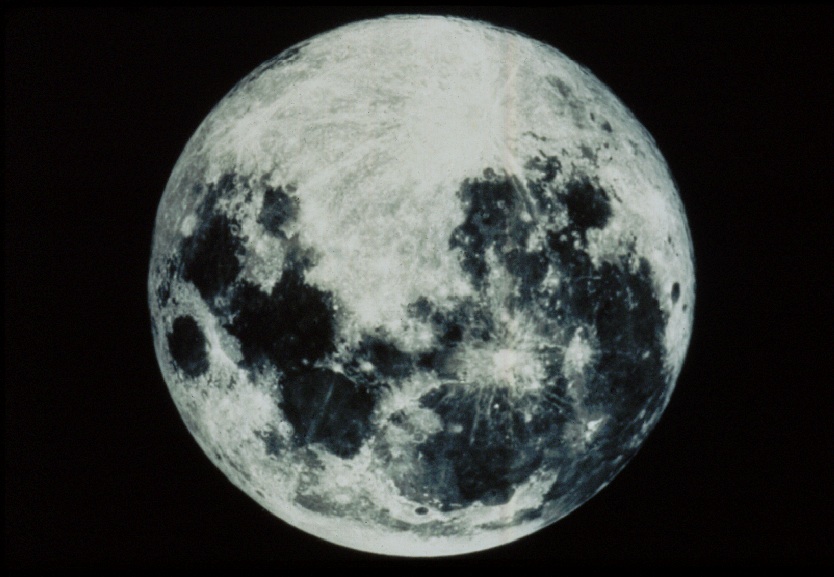
What shapes do you see on the face of the Moon?
[A man, a woman, two frogs?]
Some people see a rabbit on the Moon.
Can anyone see a rabbit in the Moon?
[Let a student point out the Rabbit in the Moon.]
VISUAL 17 (still): Red Rabbit Moon
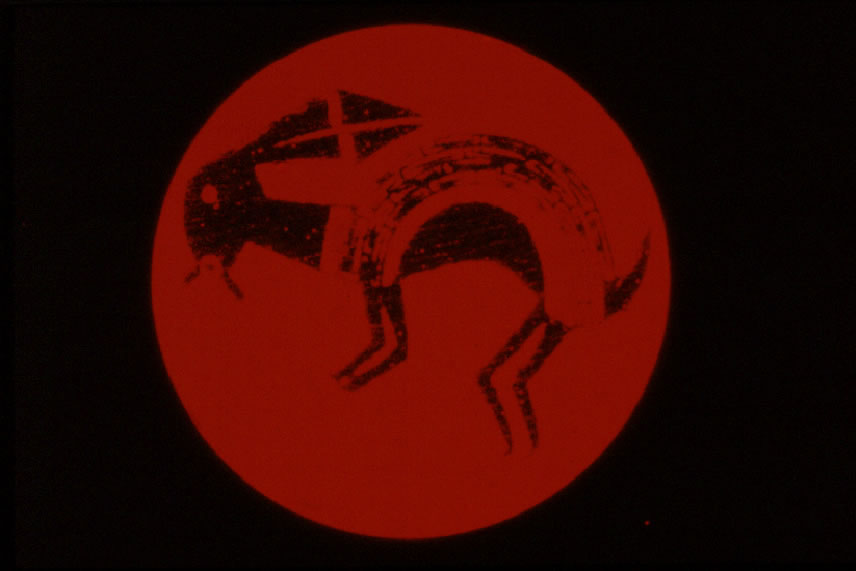
[Fade on an image of the Red Rabbit Moon image at 80% transparency, overlayed on the Full Moon image.]
This is the Anasazi figure of the Moon Rabbit. Many southwestern tribes tell stories about the rabbit. In their paintings and pottery, the rabbit represents the Moon.
DIGITAL EFFECT: Rabbit Toggle
Toggle the Red Rabbit image off. Cross fade the Full Moon with the Red Rabbit Moon overlay several times for pointing out how the maria line up with the rabbit image.
Fade off the Full Moon and the Red Rabbit image.
Imagine you are an Anasazi sky watcher about 900 years ago. The date is A.D. July 5, 1054. You can see the Moon just before sunrise.
DIGITAL EFFECT: Supernova 1054 AD
Turn on the planetarium clock for noting the date.
Suddenly, you notice a new star near the Moon.
The star is brightening, but not moving.
It is not a big meteor or a comet.
It is a very bright star that you have never seen before.
DIGITAL EFFECT: Supernova
Fade on the supernova dot over 10 seconds next to the Moon, at the location of the supernova.
DIGITAL EFFECT: Go to Sunrise
Fast forward to approximately 90 minutes after sunrise, to dawn sky.
By dawn, the star near the Moon outshines all others in the sky and it is even brighter than the Moon! The new star is so bright you can see it in the daytime sky for 23 days.
DIGITAL EFFECT: Skip 23 Days
Fade out the Moon (it will not stay in the same place from day to day) and the realtime “sky”. Brighten sky to daylight levels with supernova dot on. Run 23 sidereal days in 11.5 seconds (2 days/second). If possible, as time advances allow the sky to “flash” to give the appearance of time passing.
The strange new star’s appearance is amazing, and we think it is important enough to make a permanent record to celebrate the new star.
Let’s draw what we saw the first night near the Moon. You do not need to make this scientifically accurate. Use your artistic imagination to represent the event that you saw.
DIGITAL EFFECT: Fade to Supernova Night
Crossfade the scene back to the original date and time of the supernova (1054/07/05, approximately one hour before sunrise) for the supernova recording activity.
Hand out black paper and fluorescent chalk to record the Moon and the star together. After a minute or two of drawing, turn on black lights. After about 2-3 minutes, continue:
As you finish drawing, you may wish to tell future sky watchers who you are.
Can you think of a way to “sign” your drawing without using writing? Perhaps you can make up a special symbol that is uniquely yours.
Show your drawing to the people near you and explain how you identified yours.
Today, we call the new star a supernova and believe a supernova is actually an old star exploding.
[Have students put away the chalk. Turn off the black lights.]
VISUAL 18 (still): Chaco Canyon Petroglyph of Supernova
[Fade on image.]
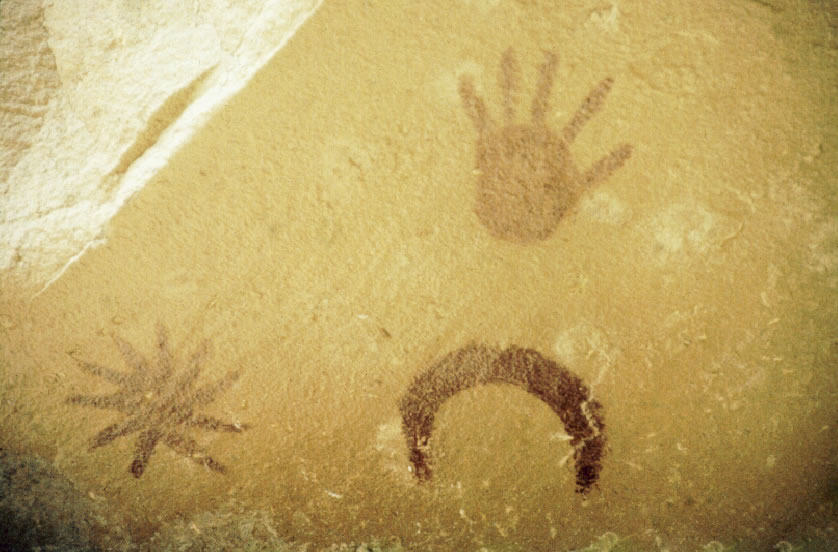
Now, let’s look at a rock painting found at Chaco Canyon.
Does it look like your drawing?
Some archaeoastronomy researchers think this petroglyph could be a record of the new star of A.D. 1054. Others dispute that idea.
At many sites in the southwestern United States and northern Mexico, people painted a Crescent Moon and a bright star. Perhaps these look like your drawing.
VISUAL 19 (still): Chalk Renderings of Petroglyphs in Southwest USA & Mexico
[Fade on image.]
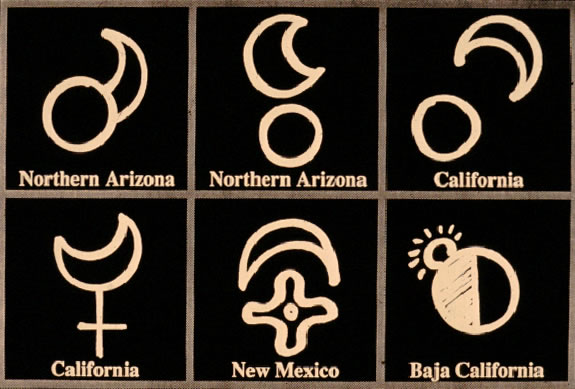
But this bowl was found among the pottery from the Mimbres Indians of southwestern New Mexico.
It has been dated to the approximate time of the supernova of A.D. 1054. Supernovae are visible only about once each century.
VISUAL 20 (still): Rabbit with Star at Foot Bowl, Mimbres Indians
Fade on image.
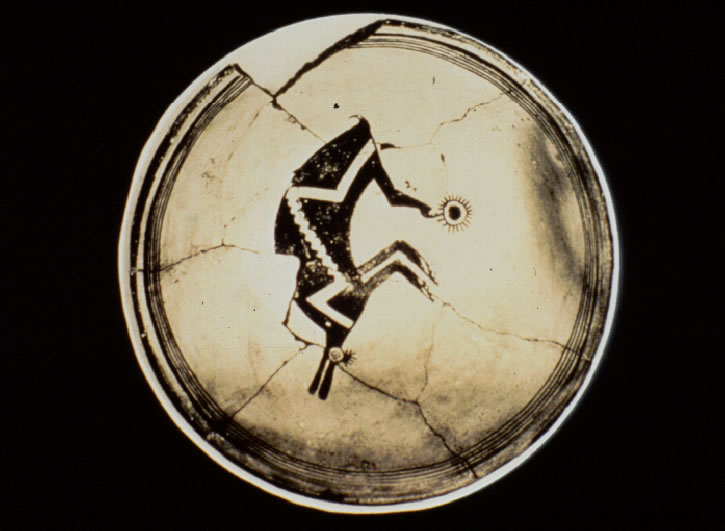
What do you think it shows?
[A rabbit and a star?]
Perhaps it is the Rabbit Moon in Crescent phase with the new star near its foot. Interestingly, the star has 23 points.
What could that symbolize?
[The number of days the supernova was visible in the sky.]
Fade off supernova record images and the supernova dot.
VISUAL 21 (still): Crab Nebula
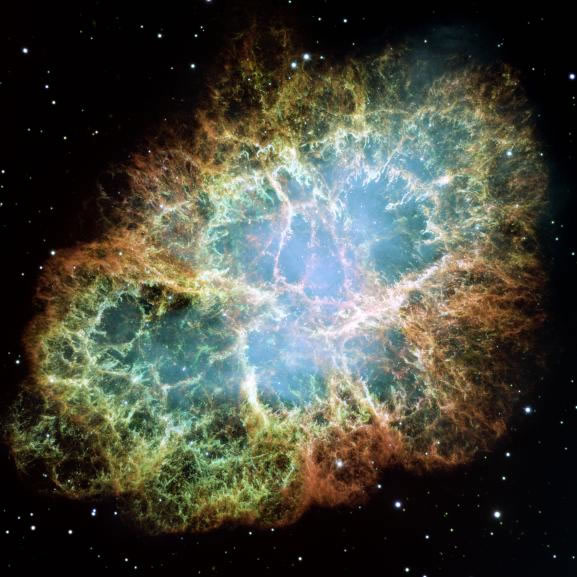
[Fade on a small image of the view of the Crab Nebula at the location of the supernova, and then scale up and move the image off to the side for viewing.]
Some people argue that the petroglyphs cannot be tied to the supernova and that similarities in all these petroglyphs can be explained in other ways. This is the way of science—theories are challenged and tested all the time.
Today, if we look with a large telescope toward the place of the new star, we find this beautiful sight: an expanding cloud of gas called the Crab Nebula. It is the remains of the star that exploded 900 years ago and certainly could have been seen over the quiet deserts of Chaco Canyon.
The Anasazi deserted Chaco Canyon almost 600 years ago. We do not know why. Their descendants, the Hopi and Zuni people, live in the same area and carry on the traditions of watching the Sun, Moon and stars. Many of the same symbols appear in their art today.
[Fade off the Crab Nebula image and turn the planetarium clock off.]
DIGITAL EFFECT (optional): Cardinal Colors
Four cardinal colored lights on at cardinal points.
Music for transition.

